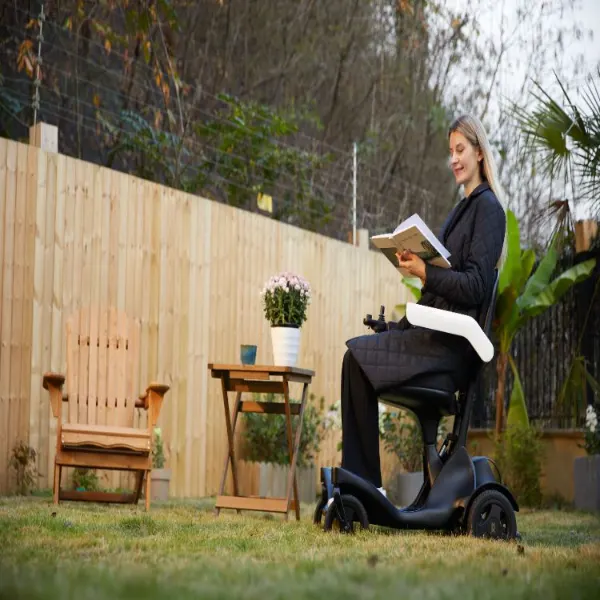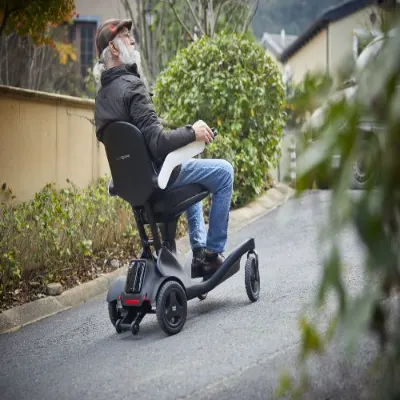
When evaluating electric wheelchairs, battery life is a crucial factor influencing daily mobility and independence. Still, door-to-door quickness comes from how easily you start, steer, stop, and stow through elevators, curb cuts, and queues. A compact power chair with dual 250 W brushless motors, calm start/stop logic, ~6 km/h top speed, 10° ramp holds, IPX4 splash resisatance, and a 21 kg net frame (battery removed) often feels quicker because you correct less and keep moving.
What “Real-World Quickness” Should You Measure?
Top speed is simple; door-to-door time is honest. Count unfold/power-on, the first meter from a standstill, 180° pivots in tight corridors, curb-lip behavior, and parking/stow time. Trim seconds in each moment and the whole route shrinks.
Which One Gets Moving Faster From a Standstill?
A fast electric wheelchair with smooth ramp-up and crisp release-to-stop launches cleanly, clears a doorway, then holds on a 10° ramp without roll-back. Predictable torque from brushless motors matters in crowds.
How Long Do Typical Routines Take?
Time three basics: fold/lock, power-on/seat, and a hallway pivot. Gas-spring assisted rigid locks make folds repeatable, so you don’t bleed time fiddling with latches.
Which Wins in Elevators, Doors, and Tight Corridors?
Elevators and narrow doors punish long wheelbases. Footprint and turning behavior beat raw speed.
Can You Pivot Inside an Elevator Without Three-Point Turns?
A chassis around 960 × 600 × 945 mm that folds to ~960 × 600 × 380 mm fits typical cars and older apartments. Omnidirectional front support helps calm 360° spins; scooters often need extra shunts.
Do Controls Allow Micro-Corrections at Low Speed?
Small joystick inputs should equal small path changes. A tidy controller plus brushless drive keeps low-speed aim steady and shoulders relaxed.
Who Handles Sidewalks, Curbs, and Ramps Better?
Think steady 5–6 km/h with clean starts and no lurch at crosswalks. On slopes, traction and brake logic separate calm from chaotic.
What About 5–6 km/h Sidewalk Flow and Crosswalk Starts?
Rear-wheel drive with integrated control gives straight launches and clean stops when you release—useful when traffic turns suddenly.
How Do Both Behave on 8–10° Ramps and Threshold Lips?
A chair rated for a 10° climb with confident brake hold is easier on polished plates. Rubber-damped rear suspension keeps chatter down at the lip.
Does “Faster” Drain the Battery Sooner?
Higher speed, stop-starts, and slopes raise draw, so plan a buffer. You don’t need heroic capacity—just enough for your longest loop plus margin. For side-by-side specs across categories, see this mobility scooter comparison.
What’s the Practical Range at Urban Pace?
Mixed indoor/outdoor trips with 3–4 km/h indoors and 5–6 km/h outside usually sit well within published bands. Repeated slopes or long outdoor legs call for higher capacity and a 20% reserve.
Are Swappable Batteries a Tie-Breaker?
Often, yes. Removable packs lighten trunk lifts and extend range without downtime—harder to match on many scooters.
Which Is Easier to Transport and Store?
Apartments and rideshares reward compact folds and balanced lifts.
Can You One-Hand Stand the Unit in a Hallway or Closet?
A rigid standing fold near 380 mm thick parks beside a shoe rack. Balanced grab points and a 21 kg frame make lifts realistic for one person.
Is It Friendly to Elevators and Trunks?
Short wheelbase, ~60 cm width, and tidy cable routing reduce snags. If your life is elevator-heavy, a foldable power wheelchair for apartments typically wins minutes every day.
What About Comfort and Stability at Speed?
Comfort is speed’s silent partner—you ride quicker when the device stays composed.
Do Solid or Pneumatic Tires Track Better on Polished Floors?
Solid tires avoid flats; with suitable tread they hold on smooth tiles. Too hard and you chatter, too soft and you drag.
How Much Suspension Travel Helps in the City?
Independent rear suspension with sealed rubber damping filters lift plates and curb cuts, so you take fewer “stabilize” taps.
Are There Rules and Limits You Must Consider?
Buildings can cap indoor speed and prefer calm profiles. Follow house rules and you stay welcome.
What Safety Features Matter Most at Higher Speeds?
Electromagnetic braking with confident hold, release-to-stop behavior, and low-glare lights. Reflective edges help in mirror-lined elevators.
Visibility and Cues in Crowds
Make brief eye contact at aisle crossings and yield at elevators, even if you arrive first. Paradoxically, that keeps you faster by avoiding “who goes first” stalls.

How Do Ownership Costs and Maintenance Compare?
Both need tires, brake checks, and battery care. Chairs often hold up better in fold-heavy, elevator-heavy life; gas-assisted locks and tight hinges stay quiet longer. Common wear—arm pads, casters, latch bushings—is straightforward to service.
Which Stays Tight and Quiet After 6–12 Months?
Look for hinge design, latch wear surfaces, and protected cable routing. Quiet mechanisms build confidence—and indirectly, pace.
Who Should Choose a Fast Electric Wheelchair, and Who a Scooter?
If your day is elevators, narrow doors, busy atriums, and short outdoor legs, a compact chair usually wins. Longer, straighter, roomier routes can favor scooters. To compare key traits without guessing, start with electric wheelchair vs scooter.
Side-By-Side Scorecard to Decide Quickly?
Rate each option 1–5 on startup time, indoor maneuverability, curb/ramp behavior, comfort at speed, transport/storage, range at urban pace, and upkeep. Weight scores toward elevator pivots and doorway behavior; that’s what decides city pace.
Buying Checklist Before You Commit?
- Measure elevator door and car width, plus your narrowest home door
- Time one fold, one power-on, and a 180° hallway pivot
- Try a trunk lift; confirm lift height and balance points
- Map your longest loop and keep a 20% energy buffer
- Check building rules and set a calm indoor profile
Introduction to Super Pi Robot
Super Pi Robot focuses on lightweight, travel-ready power chairs for real buildings. A current platform pairs dual 250 W brushless motors with a compact footprint around 960 × 600 × 945 mm and a standing fold near 960 × 600 × 380 mm, so you pivot cleanly in elevators and store beside a closet. IPX4 splash resistance handles wet sidewalks. A 21 kg net frame (battery removed) makes trunk transfers practical, and a 10° climbing spec with confident release-to-stop braking helps on ramps and plate seams. Independent rear suspension with sealed rubber damping smooths daily bumps, while a gas-assisted rigid lock keeps folds quick and consistent—fewer mid-errand stops, calmer rides.
FAQ
Q1: Which is quicker in an elevator building, chair or scooter?
A: Usually the chair—smaller footprint and tighter pivots cut resets inside cars.
Q2: Does a higher top speed guarantee faster trips?
A: Not indoors. Smooth acceleration, short stopping distance, and tight turning save more time than an extra km/h.
Q3: How much range should you plan for city errands?
A: Size for your longest loop with a 20% buffer. Stop-starts and slopes add draw.
Q4: What helps most on ramps and shiny plates?
A: Release-to-stop braking with confident hold plus rubber-damped rear suspension.
Q5: I live in a small apartment—what should I check first?
A: Door width, elevator car size, and whether the chair stands neatly when folded. If those align, daily flow gets easier.






